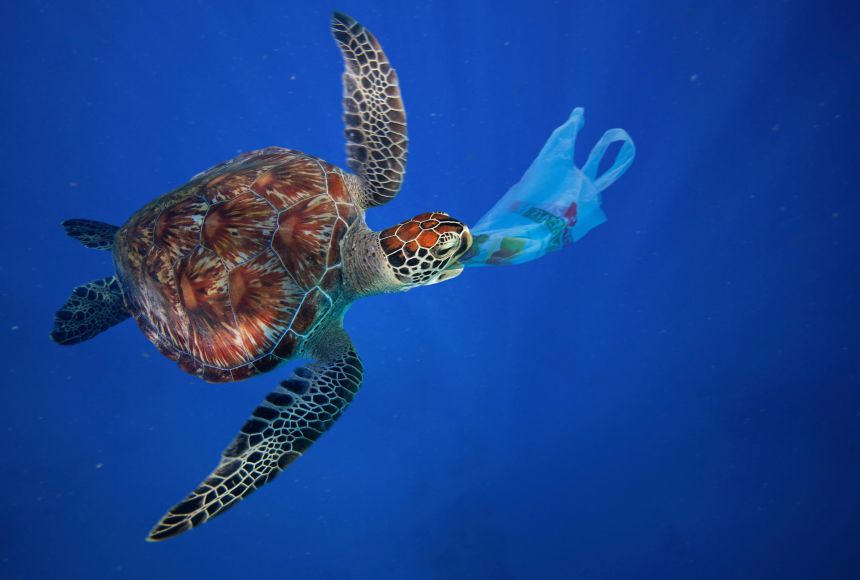Littering, storms, runoff, and winds introduce plastic waste and other debris into our waterways and eventually our oceans. According to a 2018 United Nations report on single-use plastics, more than 600 marine species are harmed by this marine debris, and 15 percent of affected species are endangered. For example, the North Atlantic Right Whale is highly endangered and also a frequent victim of harm from marine debris. This is just one of many species that could become extinct because of the growing problem of ocean pollution.
Additionally, another United Nations report, prepared in 2014 as part of the Convention on the Conservation of Migratory Species of Wild Animals, noted that the six species most negatively affected by marine debris were all migratory. It may be the case that species that change their location or traverse large areas are more likely to come into contact with some form of marine debris. However, this correlation also makes it prudent to evaluate whether any adverse relationship exists between the variables: does marine debris affect migration of animals such as whales, turtles, or seabirds?
Migration is widespread in the animal kingdom and can involve 1,600-kilometer (1,000-mile) journeys. Understanding if and how marine debris may be disrupting animal migrations may be relevant to ecosystems globally since migratory species can occupy ecosystems thousands of kilometers apart. To begin to assess what impacts, if any, marine debris has on migration, one must first understand the types of immediate and long-term health consequences associated with interactions between animals and the debris.
Negative effects of marine pollution primarily occur when an organism becomes tangled in debris (entanglement) or consumes the debris (ingestion). Some animals are affected via both pathways; for example, both entanglement and ingestion are commonly seen in turtles, with past studies estimating as many as 86 percent of turtles are affected worldwide.
Entanglement can injure or even kill animals. In turtles, for example, common wounds are severed flippers. Such wounds may have effects beyond pain and infection—they may inhibit locomotion, which can reduce the ability to find and procure food or evade predators. Even if entanglement is not directly injurious, it can still compromise an animal’s survival.
The effects of entanglement have the potential to impact an animal’s reproductive fitness. Migration is sensitive to timing, and animals that arrive late may face difficulties foraging, mating, and ultimately preserving their lineage.
Ingestion of marine plastic also has negative health effects on species. Turtles, in particular, confuse plastic bags with their typical prey—jellyfish—and eat them. Seabirds are another unfortunate victim of marine plastic ingestion. In fact, the 2014 United Nations report on migratory species stated that turtles and birds were the animals most likely to be affected by ingestion of marine debris.
When these animals consume debris, it can lead to a number of negative consequences for their health. Internal injury can result from eating sharp objects. Plastic debris can also block the digestive tract, leading to malnutrition or causing animals to feel falsely satiated. As a result, they will stop eating before they have gained adequate nutritional value from a meal. Additionally, plastic particles may absorb other harmful chemicals from the environment and introduce toxins into the food chain.
For seabirds, it is critical that they consume a sufficient amount of nutrients to support migration and reproduction. Consumption of marine plastic debris is inhibiting the ability of many of these species to amass adequate fat stores for these activities. Without proper nutrition, birds may not be capable of migrating at all and can die as cold weather moves into an area—or they may need to make additional stops during migration to feed or spend more time in stopping points. Since timing is critical for migration, late arrival at breeding sites may be accompanied by depleted food resources and nesting sites—ultimately resulting in decreased reproductive fitness for birds effected by ocean debris ingestion.
On the opposite end of the spectrum, marine debris is also increasing migration capabilities for some organisms. According to the Smithsonian Institution, more than 1,200 marine species, from algae to fish, live and grow on the debris within the ocean. This debris travels with ocean currents across large distances. By serving as a raft that enables migration to new habitats, marine debris may thus lead to the introduction of invasive species, and possibly diseases, to new areas.
Fortunately, environmentalists are taking action to mitigate the marine debris crisis. For example, National Geographic Explorer and marine biologist Heather J. Koldewey developed the Net-Works project, which began as an initiative to recycle discarded fishing nets into carpet tiles and has since expanded to develop multiple solutions to the problem of marine plastic pollution. According to the Net-Works website, the group has removed 208 metric tons (208,000 kilograms; 458,562 pounds) of waste fishing nets since 2012.
In addition, National Geographic Explorer and environmental engineer Jenna Romness Jambeck is studying how marine debris moves within our ocean, which informs strategies on how to combat its effects. Jambeck has co-authored several research papers discussing plastics and their contribution to marine debris.
Without human intervention that builds on these types of efforts pioneered by National Geographic Explorers, the future of marine pollution and its effects on wildlife may be bleak. In a 2015 Report in Science magazine, Jambeck wrote that if waste management of plastics is not improved, the mass of plastics entering our ocean could grow drastically by 2025.
